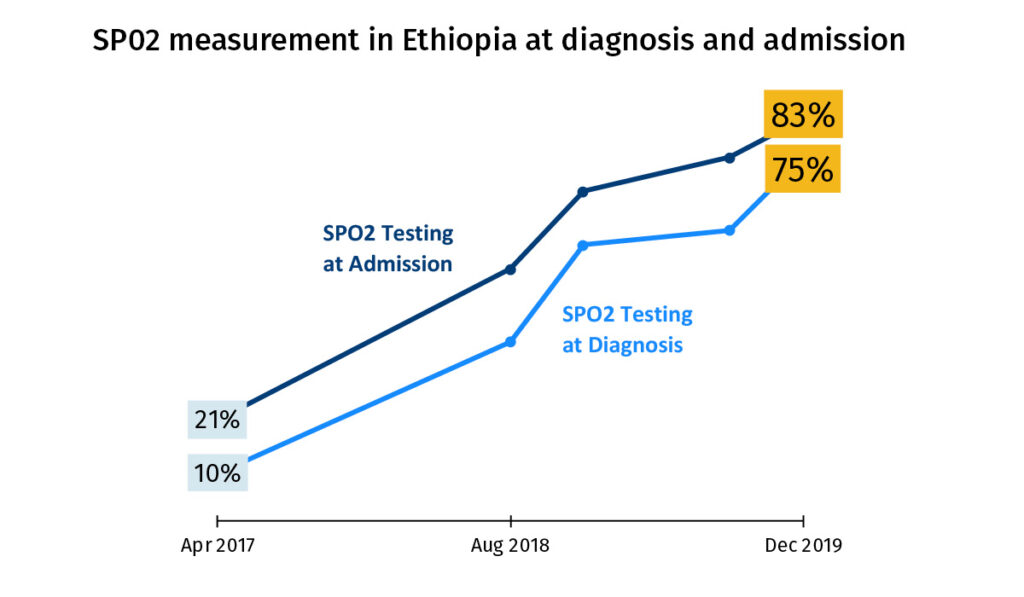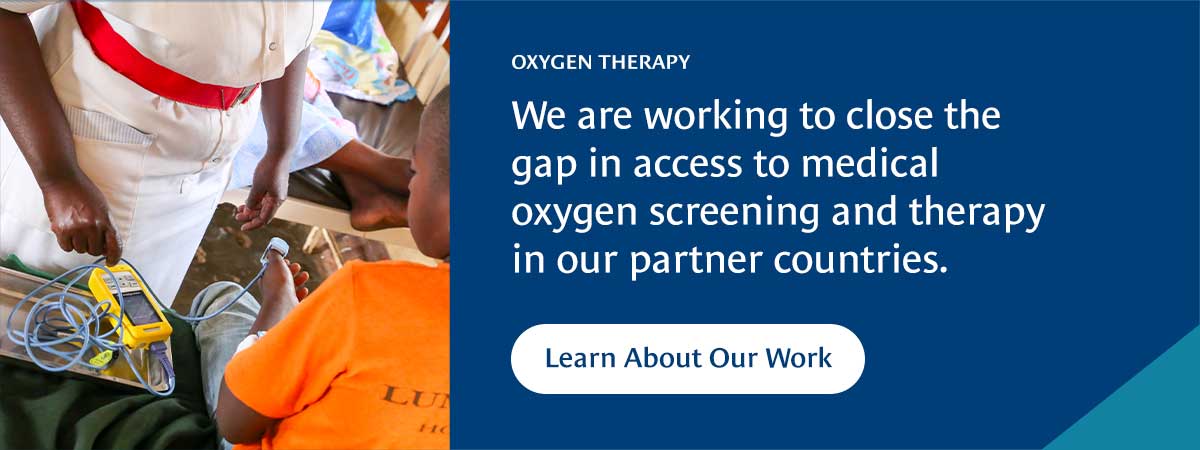Background
Medical oxygen is a lifesaving medicine used to treat low blood oxygen or hypoxemia in patients with a variety of medical illnesses such as pneumonia, acute respiratory distress syndrome, and chronic obstructive pulmonary disease and cannot be substituted. However, in low-resource settings, it is frequently unavailable in health facilities resulting in a high number of oxygen-related deaths.
Ethiopia has an estimated population of about 121 million, making it Africa’s second most populous country after Nigeria. Better access to oxygen in Ethiopia could help prevent over 100, 000 deaths of women and children each year.
In Ethiopia, pneumonia is the second leading cause of death and the leading cause of admission. Yet, oxygen equipment and expertise are limited across the health system, particularly in lower-level facilities where the majority of the population access care. The baseline assessment of Ethiopia’s Oxygen Roadmap indicated only eight percent of health centers provided oxygen therapy. The same study also found that many facilities lacked sufficient capacity and training on the clinical use of medical oxygen—only 14 percent of hospitals had healthcare workers trained on the use of medical oxygen.
Theory of change
In 2016, the Clinton Health Access Initiative in collaboration with the Ministry of Health of Ethiopia developed and implemented the first-of-its-kind five-year National Medical Oxygen and Pulse Oximetry Scale-up Roadmap. The roadmap provided a framework to standardize and avail medical oxygen and expand pulse oximetry use nationally. By 2021, an end-line assessment showed great progress; (e.g., increased oxygen production and provision of oxygen services), challenges encountered, and lessons learned. However, prominent unmet needs remain, especially at the primary healthcare level. To build on gains achieved to date and address critical gaps, a second national roadmap has been developed.
Approach
The Ministry of Health (MOH) seeks a comprehensive approach to overcome the prevailing bottlenecks and improve access to medical oxygen, diagnostics, and hypoxemia management in health facilities at all levels as the country moves towards achieving targets set by the Health Sector Transformation Plan (HSTP II). To address identified gaps, scale up best practices from the previous roadmap implementation, and contribute to building a resilient health system, Clinton Health Access Initiative (CHAI) in partnership with Ministry of Health developed and launched the second national medical oxygen roadmap which highlighted seven areas of strategic interventions that will significantly increase the availability of oxygen and improve proper management of hypoxemia. These strategic areas include improving (i) policy and coordination (ii) equitable access to medical oxygen and diagnostics (iii) quality care and rational use of oxygen (iv) oxygen commodities management (v)regulatory capacities (vi) Research and innovation and (vii) Sustainable financing mechanisms.
Impact/Results
This Roadmap created a solid foundation for coordinating and mobilizing resources for COVID-19 response and maintaining essential services. After the launch of the first roadmap, the percentage of hypoxemia cases identified in health facilities rose from 21 to 83 percent. Moreover, compliance with oxygen therapy guidelines increased dramatically and the number of patients receiving oxygen increased from 72 to 91 percent.

According to the Roadmap’s end-term assessment, the country’s oxygen production capacity has significantly improved in the last five years from 330 to 2904.5 m3/hr. Prior to the implementation of the roadmap, medical oxygen plants were limited to a few regions but huge gaps in geographical disparities have been resolved, with plants available almost in all regions.
“Previously we used to travel about 1000 km twice a month to refill medical oxygen with more than ETB 2.6 million for operational cost but with the installation and operationalization of the oxygen plant in our hospital, we avoided long-distance travel and on top of this, the plant enabled us to save the aforementioned amount annually… currently there are no referrals and surgical cancellations related to medical oxygen.”
Bonga General Hospital
Next Steps
Despite several improvements in terms of production capacities, availability of oxygen devices and provision of oxygen therapy services, there are still unmet needs for oxygen therapy services that are more prominent at the primary healthcare level. Therefore, CHAI in partnership with MOH and with the active engagement of private sectors will accelerate the implementation of the oxygen roadmap to ensure sustainable access and quality of medical oxygen at all levels of the health system. Additionally, CHAI with the Ministry will also work towards improving standardization and regulatory systems of medical oxygen.






